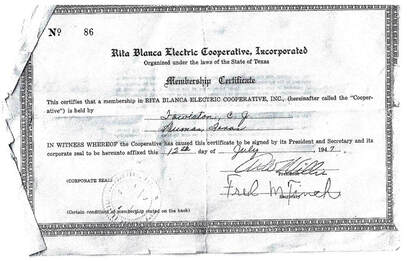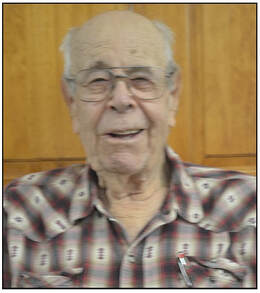Electricity Came to Rural Panhandle in 1947
 Membership certificate for C. J. Fowlston, 1947
Membership certificate for C. J. Fowlston, 1947
Rural Texas Panhandle observed a milestone in 2021. Seventy-five years ago, rural electrification began in the Panhandle.
Getting electricity to the rural areas of the Panhandle was not an easy task, but two men from Moore County were part of the group that made it possible.
In the early spring of 1945, W. J. Morton and former County Judge Fred Makeig were asked by the county agent to meet with others from Dallam, Hartley, Sherman, and Moore Counties to explore the possibility.
According to Morton, in his book Snowstorms, Dust Storms and Horses' Tails, the story begins, "I think it was the early spring of 1945 when the couth agent came to me one day and asked me to go to Texline with a bunch of them. He said they were talking of trying to organize a Rural Electric Co-op there on a certain date."
Morton was a little skeptical of the idea, but he agreed to meet with the group. "I came to town and went off up there thinking the whole thing was out of the picture."
The group spent the afternoon and organized the Rita Blanca Electric Cooperative with headquarters in Dalhart. Morton and Judge Makeig were named to the original board of directors to represent Moore County.
Just organizing the board and naming the cooperative did not get the job done and according to Morton, "We had some pretty tenacious businessmen on the board that didn't know just what the word "no" meant."
The board went to Washington and began the application process. A loan was applied for and it was approved. The Rural Electric Cooperative lent the new cooperative the money to buy a small electric company in Texline, which was the beginning of bringing electricity to the four counties.
Rita Blanca built lines into the counties for a few years as money was available and then REC declined further loans. Their new proposition was that the customer would pay so much a mile on the construction and then pay the regular monthly rates. Morton says, "There was quite a bit of outlying country that didn't have any electricity and when we approached them with this kind of deal, they wouldn't go along with it."
"They said, you have electricity and it didn't cost you any such and we think we are entitled to the same treatment -- which I could readily agree."
According to Morton, "Finally, we got a couple of fellows our of Washington in an all-day meeting in Dalhart and worked out a plan whereby we could go up on the rate a little and they would give us area coverage." This made coverage for the four counties possible. "This didn't exactly suit some of our old customers, but they weren't too upset about it."
Morton ends his story by relaying an encounter he had with a rural electricity customer. "One party in Moore County came to me one morning and said, 'what do you mean by going up on the electric rates?' I told him that it just means that your neighbor can get electricity the same as you have. His taxes go to pay for this thing the same as yours do and he is just as entitled to juice as you are and you know it. That ended it and he said no more."
Getting electricity to the rural areas of the Panhandle was not an easy task, but two men from Moore County were part of the group that made it possible.
In the early spring of 1945, W. J. Morton and former County Judge Fred Makeig were asked by the county agent to meet with others from Dallam, Hartley, Sherman, and Moore Counties to explore the possibility.
According to Morton, in his book Snowstorms, Dust Storms and Horses' Tails, the story begins, "I think it was the early spring of 1945 when the couth agent came to me one day and asked me to go to Texline with a bunch of them. He said they were talking of trying to organize a Rural Electric Co-op there on a certain date."
Morton was a little skeptical of the idea, but he agreed to meet with the group. "I came to town and went off up there thinking the whole thing was out of the picture."
The group spent the afternoon and organized the Rita Blanca Electric Cooperative with headquarters in Dalhart. Morton and Judge Makeig were named to the original board of directors to represent Moore County.
Just organizing the board and naming the cooperative did not get the job done and according to Morton, "We had some pretty tenacious businessmen on the board that didn't know just what the word "no" meant."
The board went to Washington and began the application process. A loan was applied for and it was approved. The Rural Electric Cooperative lent the new cooperative the money to buy a small electric company in Texline, which was the beginning of bringing electricity to the four counties.
Rita Blanca built lines into the counties for a few years as money was available and then REC declined further loans. Their new proposition was that the customer would pay so much a mile on the construction and then pay the regular monthly rates. Morton says, "There was quite a bit of outlying country that didn't have any electricity and when we approached them with this kind of deal, they wouldn't go along with it."
"They said, you have electricity and it didn't cost you any such and we think we are entitled to the same treatment -- which I could readily agree."
According to Morton, "Finally, we got a couple of fellows our of Washington in an all-day meeting in Dalhart and worked out a plan whereby we could go up on the rate a little and they would give us area coverage." This made coverage for the four counties possible. "This didn't exactly suit some of our old customers, but they weren't too upset about it."
Morton ends his story by relaying an encounter he had with a rural electricity customer. "One party in Moore County came to me one morning and said, 'what do you mean by going up on the electric rates?' I told him that it just means that your neighbor can get electricity the same as you have. His taxes go to pay for this thing the same as yours do and he is just as entitled to juice as you are and you know it. That ended it and he said no more."
 Charles "Bub" Sheldon
Charles "Bub" Sheldon
Rita Blanca had a big job to get ready to provide electricity to the four counties. Right of ways had to be obtained, poles erected and lines run to the customers. Charles "Bub" Sheldon remembers when electricity made it to their family farm, east of Dumas. It had taken almost a year from the time Rita Blanca started working on setting poles and stringing lines. The farm had been generating electricity with 32-volt wind chargers and sets of batteries in the cellar and barn to power lights.
When the house was lighted with gas lights, the family would have to turn them off because they heated the house too much. Then, they would be in the dark, so electricity was a welcome change.
The wires that handled the battery-powered lighting system, could not be used for the 110-volt electricity, so the house and barn had to be rewired and plug-ins installed.
Bub remembers on laundry day when his mother, Nola, would have aline of flat irons on top of the wood stove, so she would always have a hot iron ready as one cooled off. She quickly made use of the new convenience and purchased an electric iron and food mixer.
In 1977, Bub was named to the board of directors for the Golden Spread Electric Coop, which included Deaf Smith Electric Coop in Hereford, North Plains Electric Coop in Perryton, Greenbelt Electric Coop in Wellington, Rita Blanca Electric Coop in Dalhart and Tri County Electric Coop in Hooker, OK. He still serves on that board and Golden Spread is now the fourth largest cooperative in Texas. It serves eleven cooperatives from the Lubbock area to the Panhandle.
Golden Spread owns two generating plants, one in Denver City, built in the 1980s and another in Abernathy, built in 2013. Bub says when he was asked to sign his name to a contract for $200 million to build the Denver City plant, it was hard for a "farm boy" to realize he was liable for that amount of money. The cooperative also has a wind turbine farm with 37 turbines. He still serves on the board and has watched it grow steadily for over forty years.
When the house was lighted with gas lights, the family would have to turn them off because they heated the house too much. Then, they would be in the dark, so electricity was a welcome change.
The wires that handled the battery-powered lighting system, could not be used for the 110-volt electricity, so the house and barn had to be rewired and plug-ins installed.
Bub remembers on laundry day when his mother, Nola, would have aline of flat irons on top of the wood stove, so she would always have a hot iron ready as one cooled off. She quickly made use of the new convenience and purchased an electric iron and food mixer.
In 1977, Bub was named to the board of directors for the Golden Spread Electric Coop, which included Deaf Smith Electric Coop in Hereford, North Plains Electric Coop in Perryton, Greenbelt Electric Coop in Wellington, Rita Blanca Electric Coop in Dalhart and Tri County Electric Coop in Hooker, OK. He still serves on that board and Golden Spread is now the fourth largest cooperative in Texas. It serves eleven cooperatives from the Lubbock area to the Panhandle.
Golden Spread owns two generating plants, one in Denver City, built in the 1980s and another in Abernathy, built in 2013. Bub says when he was asked to sign his name to a contract for $200 million to build the Denver City plant, it was hard for a "farm boy" to realize he was liable for that amount of money. The cooperative also has a wind turbine farm with 37 turbines. He still serves on the board and has watched it grow steadily for over forty years.
 Harold Dean Morton
Harold Dean Morton
Before rural electrification made it to the W. J. Morton farm in the Palo Duro School area, Harold Dean Morton remembered coming in from school and starting his chores. One of those chores was to make sure the generator had enough fuel to run the lights. It was not a job he enjoyed, so when the farm was connected to Rita Blanca Electric Cooperative in 1947, he was especially happy. Now, he could come in, turn on the radio and enjoy programs like "Jack Armstrong, the All American Boy" or "Amos and Andy".
Before electricity, the Morton home had been lighted, first with candles and kerosene lamps. Then, carbide lights were installed and were powered by a generator buried in the ground. In 1936 or 1937, natural gas lights were installed, then a wind charger was used, and finally a 110-volt generator.
Harold Dean especially remembered the wind charger. "It worked great as long as the wind was blowing, but if the wind stopped and you were listening to the radio -- you didn't hear the end of the program."
Electricity made life easier for the entire family. His mother no longer had to keep a row of flat irons hot on the stove when she was doing the ironing. An electric refrigerator was installed to replace the natural gas Servel refrigerator she had been using. An electric motor was installed on the Maytag washing machine to replace the "kick-start" motor that seemed to always be hard to start and required maintenance.
An electric pump was installed on the water well, so there was always water available regardless of whether the wind was making the windmill pump.
The last pole that was set on the farm that made the electric connection possible is still there and connects the farm with electricity.
Harold Dean remembers, at the beginning there were times when the electricity would go off for periods of time, but as Rita Blanca acquired equipment to service customers, those outages were fewer. "Now the company has good equipment and good personnel to take care of its customers and rural electricity has made rural living and farming easier," according to Harold Dean.
Before electricity, the Morton home had been lighted, first with candles and kerosene lamps. Then, carbide lights were installed and were powered by a generator buried in the ground. In 1936 or 1937, natural gas lights were installed, then a wind charger was used, and finally a 110-volt generator.
Harold Dean especially remembered the wind charger. "It worked great as long as the wind was blowing, but if the wind stopped and you were listening to the radio -- you didn't hear the end of the program."
Electricity made life easier for the entire family. His mother no longer had to keep a row of flat irons hot on the stove when she was doing the ironing. An electric refrigerator was installed to replace the natural gas Servel refrigerator she had been using. An electric motor was installed on the Maytag washing machine to replace the "kick-start" motor that seemed to always be hard to start and required maintenance.
An electric pump was installed on the water well, so there was always water available regardless of whether the wind was making the windmill pump.
The last pole that was set on the farm that made the electric connection possible is still there and connects the farm with electricity.
Harold Dean remembers, at the beginning there were times when the electricity would go off for periods of time, but as Rita Blanca acquired equipment to service customers, those outages were fewer. "Now the company has good equipment and good personnel to take care of its customers and rural electricity has made rural living and farming easier," according to Harold Dean.